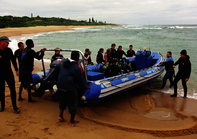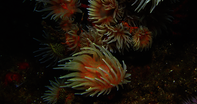Best Kept Secret of the South Coast
Rocky Bay is one of the best kept secret diving spots on the South African coast. Much like Aliwal Shoal, and just to the south of it, a group of reefs lie between two and four kilometres offshore across Rocky Bay.

Because the dive spots are a little bit deeper and range from 20 m to 40 m, it is advisable to have an advanced qualification.
Like the Aliwal Shoal, Rocky Bay is also fossilized sand dunes with drop-offs, gullies and overhangs. With only a few dive operators in this area, the reefs are untouched and an abundance of reef fish are likely to be seen.
This was a popular fishing spot for fisherman to catch the large game fish and a number of shark species are commonly seen on the reefs.
Top Diving Spots in Rocky Bay

Half Acre - Average depth: 17m
This area has huge boulders and gullies that are connected to a flat piece of reef. The boulders look as if they were dropped from heaven. It is recommended that divers stay in a close group as the rock formations on this reef can cause the divers to lose sight of the dive master. Coral on the reef is made up predominantly of soft coral.
Surfaces are covered with seaweed with lots of Nudibranchs in and between the crevices. Tropical fish roam around freely and be on the lookout for crayfish in small caves and overhangs. Natal catfish, Batfish, Trumpetfish and Idols are common sightings. Game fish are always in the vicinity.
Outside Landers - Average depth: 20 m
Outside Landers is a wall-like reef that runs from north to south. On the ledge you will find pinnacles which make a good enclosure for marine life and which stand out a couple of metres above the rest of the reef. The boulders create nice swim-throughs and gullies.
As this is one of the deeper dives there tend to be thermoclines here and there, yet you may still encounter Bluefin kingfish, while tropical fish can also be seen. A school of Batfish has been spotted as well as fusiliers and Ragged-tooth sharks – Nudibranchs and crayfish peeping out of theholes.
Coral life, like most of the other reefs in this area, consists of more soft than hard coral. Whip coral, Purple and White thistle coral, Lettuce coral, Sea urchins and much more can be seen on this reef.
Butchers Reef - Average depth: 18 m
Boulders, rocks with big crevices and gullies are some of the characteristics of this reef north of Landers. The reef has a wall-like formation that is approximately 6 m high. Tropical fish such as Trumpetfish, Geometric moray eel, Natal catfish, Speckled shrimpfish, Batfish and False stonefish are just some of the marine life one will encounter on this reef.
A resident Loggerhead turtle that sleeps in one of the many caves and overhangs can usually be seen. This reef is also known as the ‘Juvenile Nursery’. Many species of hard and soft coral can be found on this reef, as well as anemones.